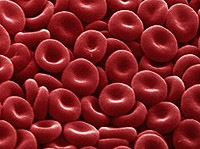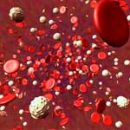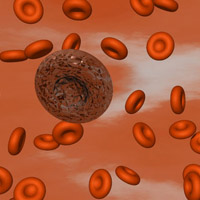In what cases is developing disseminated intravascular coagulation syndrome? How does this state manifest? Answers to these questions are set forth in this article.
Content
 Disseminated intravascular coagulation (DVS syndrome, thrombohemorrhagic syndrome, coagulopathy consumption) - life-threatening violation of blood coagulation due to massive release from tissue of thromboplastic substances.
Disseminated intravascular coagulation (DVS syndrome, thrombohemorrhagic syndrome, coagulopathy consumption) - life-threatening violation of blood coagulation due to massive release from tissue of thromboplastic substances.
Most often, the DVS syndrome is found at:
- obstetric pathology;
- metastases of malignant neoplasms;
- severe injuries;
- Bacterial sepsis.
In the DVS syndrome, blood coagulation is sharply accelerated and thrombosis and embolism of small vessels arise (T.E. Blood vessel blocking plugs listed in them).
Following the initial thrombotic phase of the DVS syndrome, secondary fibrinolysis is developing,.E. The dissolution of the protein forming the foundation of the thrombus.
How manifested by the FCs syndrome
Manifestations of disseminated intravascular coagulation depend on the severity of the process and its phase.
Most patients have:
- abundant hemorrhagic rash (t.E. rash, due to the release of red blood cells beyond the vessels on the skin);
- Bloodfaction of mucous, operating wounds, standing places catheters.
Less frequently, the DVS syndrome begins with a blue color of the limbs, thrombosis and necrosis in zones, where the blood flow in the spasme and thrombing of small vessels suffers the most (fingers, genitals, nose tip).
Chronic DVS syndrome (especially associated with malignant neoplasms) may be limited to changes in laboratory indicators.
The tendency to bleeding to the greatest extent correlates with a decrease in the level of fibrinogen - the protein synthesized in the liver and participating in the formation of a thrombus.
Excessive activation of the coagulation system is accompanied by the deposition of an insoluble protein forming the framework of the tomb in small vessels, which can lead to the destruction of red blood cells.
Micrangiopathic hemolytic anemia (depositing of the insoluble protein generated by the foundation of blood cloth) on the walls of the arteriol is observed about each fourth patient with disseminated intravascular coagulation. True, the degree of destruction of erythrocytes, accompanied by the yoglobin output, in such patients is not as high as, say, in patients with hemolytic-uremic syndrome.









